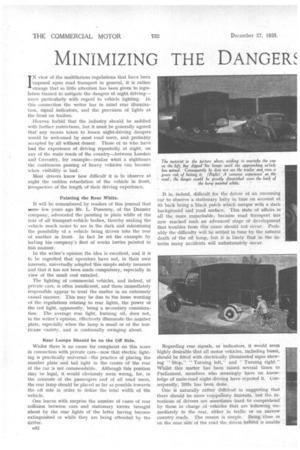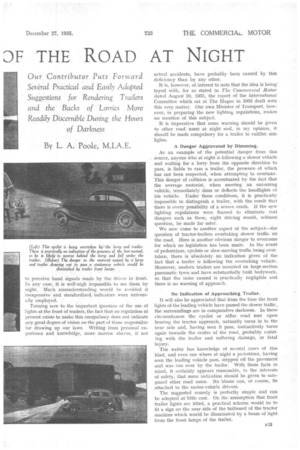MINIMIZING THE DANGER.
Page 38

Page 39

Page 40

If you've noticed an error in this article please click here to report it so we can fix it.
DF THE ROAD AT NIGHT IN view of the multifarious regulations that have been imposed upon road transport in general, it is rather strange that so little attention has been given to legislation framed to mitigate the dangers of night, driving-.-more particularly with regard to vehicle lighting. in this connection the writer has in mind rear illumination, signal indicators, and the provision of lights at the front on trailers.
;Heaven forbid that the industry should be saddled with further restrictions, but it niust be generally agreed that any means taken to lessen night-driving dangers would be welcomed by most road users, and probably accepted by all without demur. Those of us who have had the experience of driving repeatedly at night, on any of the main roads of the country—between London and Coventry, for example—realize what a nightmare the continuous passing of heavy vehicles can become when visibility is bad.
Most drivers know how difficult it is to observe at night the sudden retardation of the vehicle in front, irrespective of the length of their driving experience.
Painting the Rear White.
It will be remembered by readers of this journal that some few years ago Mr. L. Pomeroy, of the Daimler company, advocated the painting in plain white of the rear of all transport-vehicle bodies, thereby making the vehicle much easier to see in the dark and minimizing the possibility of a vehicle being driven into the rear of another in front. In fact he set the example by haidng his. company's fleet of works lorries painted in this manner.
In the writer's opinion the idea is excellent, and it is to be regretted that operators have not, in their own interests, universally adopted this simple safety measure and that it has not been made compulsory, especially in view of the small cost entailed.
The lighting of commercial vehicles, and indeed, of private cars, is often insufficient, and those immediately responsible appear to treat the matter in an extremely casual manner. This may be due to the loose wording of the regulations relating to rear lights, the power of the red light, apparently, being a secondary consideration. The average rear light, burning oil, does not, in the writer's opinion, effectively illuminate the number plate, especially when the lamp is small or of the hurricane variety, and is continually swinging about.
Rear Lamps Should be on the Off Side.
Whilst there is no cause for complaint on this score in connection with private cars—now that electric lighting is practically universal—the practice of placing the number plate and tail light in the centre of the rear of the car is not commendable. Although this position May be legal, it would obviously seem wrong, for, in the interests of the passengers and of all road users, the rear lamp should be placed as far as possible towards the off side in order to define the total width of tffe vehicle.
One learns with surprise the number of cases of rear collision between cars and stationary lorries brought about by the rear lights of the latter having become extinguished or while they are being attended by the dri*er.
13s2
It is, indeed, difficult for the driver of an oncoming -car to observe a stationary lorry in time on account of ifs back being a black patch which merges with a dark background and road surface. This state of affairs is all the more remarkable, because road transport has now reached such an advanced stage of development that troubles from this cause should not occur. Probably the difficulty will be settled in time by. the natural death of the oil lamp, but it is likely tha,t in the interim many accidents will unfortunately occur.'
Regarding rear signals, or indicators, it would seem highly desirable that all motor vehicles, including buses, should be fitted with electrically illuminated signs show ing "Stop," "Turning left," and "Turning right.'' Whilst this matter has been raised several times in Parliament, members who seemingly have no knowledge of main-road night driving have rejected it. Cori sequently, little has been done.
One is naturally rather diffident in suggesting that there should be more comPui§ory fitments, but the intentions of drivers are sometimes hard to comprehend by those in charge of vehicles that are following immediately to the 'rear, either in traffic or on narrow` country roads. The reason. is simple. Being close in 'on the near side of the road 'the driver behind is unable'
to perceive hand signals made by the driver in front. In any case, it is well-nigh impossibia to see .them by night. Much misunderstanding would be avoided if inexpensive and standardized, indicators were univers
ally employed. . • Turning now to the important question of the use of lights at the front of trailers, the fact that no regulation at present exists to make this compulsory does not indicate any great degree of vision on the part of those responsible for drawing up our laws. Writing from personal experience and knowledge, more narrow shaves, if not actual accidents, have probably been caused by this deficiency than by any other.
It is, however, of interest to note that the idea is being toyed with, for as stated in The Commercial Motor dated August 30, 1935, the report of the International 'Committee which sat at The Hague in 1933 dealt with this very matter. Our own Minister of Transport, however, in preparing the new lighting regulations, makes no mention of this subject.
It is imperative that some warning should be kiven to other road users at night and, in my opinion, it should be made compulsory for a trailer to exhibit side lights.
A Danger Aggravated by Dimming.
As an example of the potential danger from this source, anyone who at night is following a slower vehicle and waiting for a lorry from the opposite direction to pass, is liable to ram a trailer, the presence of which has not been suspected, when attempting to overtake. This danger of collision is accentuated by the fact that the average motorist, when meeting an oncoming vehicle, immediately dims or deflects the headlights ot his vehicle. Under these conditions, it is practically impossible to distinguish a trailer, with the result that there is every possibility of a sevei-e crash. 11 the new lighting regulations were framed to eliminate real dangers such as these, night driving would, without question, be made far safer.
We now come to another aspect of the subject—the question of tractor-trailers overtaking slower traffic on the road. Here is another obvious danger to overcome for which no legislation has been made. in the event of pedestrians, cyclists or slow-moving traffic being overtaken, there is absolutely no indication given of the fact that a trailer is following the overtaking vehicle. Moreover, modern trailers are mounted on large-section pneumatic tyres and have substantially built bodywork, so that the noise caused is practically negligible and thereis no warning of approach.
No Indication of Approaching Trailer.
It will also be appreciated that from the time the front lights of the leading vehicle have passed the slower traffic, the surroundings are in comparative darkness. In these circumstances the cyclist or other road user upon hearing the tractor approach, naturally turns in to the near side and, having seen it pass, instinctively turns again towards the centre of the road, probably colliding with the trailer and suffering damage, or fatal injury.
The writer has knowledge of several cases of this kind, and even one where at night a pedestrian, having seen the leading vehicle pass, stepped off the pavement and was run over by the trailer. With these facts in mind, it certainly appears reasonable, in the interests of safety, that some indication should be given to safeguard other road users. No blame can, of course, Be attached to the motor-vehicle drivers.
The suggested remedy is perfectly simple and can be adopted at little cost. On the assumption that front trailer lights are fitted, a practical scheme would be to fit a sign on the near side of the tailboard of the tractor machine which would be illuminated by a beam of light from the front lamps of the trailer. This sign could be worded, "Trailer Following," and could be surrounded by reflector glasses ; this should immediately draw the attention of those concerned and convey the desired information. The sign could be suitably hinged to enable it to be reversed, thereby presenting a plain surface when no trailer was attached.
Another method would be to have the lettering sand blasted and painted on the trailer headlamp glasses, from which the beam of light would be projected on to the white tailboard of the tractor in a similar manner to a magic-lantern picture. This arrangement has the advantage that the wording would be present only when the trailer was in use.
In conclusion, the writer suggests that the severity of many of the head-on collisions, due either to foggy weather or faulty lights, would be greatly minimized by the universal employment of substantial spring bumpers fixed at a standard. height. These would reduce the concussion and tends to prevent the telescoping.of the
radiator, bonnet and engine, and the possibility of injury to the crew.
All the foregoing remarks deal with small points in transport operation, but, combined, they constitute a natural contribution to road safety.












































































